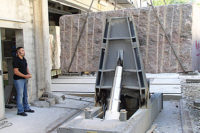
To process slabs of travertine from Italy and abroad, Aretina Marmi srl of Lucignano, Arezzo, Italy, invested in a high-tech slab processing line from Breton S.p.A. of Italy.

Slabs are first processed on a Levibreton KFG polishing line, which is equipped with 13 polishing heads.

Filler is applied by hand because the process requires personal attention to make sure all areas of the slab's surface are properly treated - with some areas needing more filler than others.

Slabs are automatically loaded and unloaded from the line using automated machinery from Breton.

The company processes travertine from its two travertine quarries in Italy, and it also began processing blocks of travertine from Peru earlier this year.

In addition to slab material, the company also processes some three-dimensional work in travertine - primarily for the local market.

Cubic stonework is fabricated using an Antea bridge saw from CMS/Brembana, which can be programmed for complex workpieces.




